This website uses cookies so that we can provide you with the best user experience possible. Cookie information is stored in your browser and performs functions such as recognising you when you return to our website and helping our team to understand which sections of the website you find most interesting and useful.
THE CARRIAGE OF VEHICLES IN BULK CARRIERS – INCLUDING ADVICE ON SAFE STOWAGE
Published: 7 May 2020
Britannia’s Loss Prevention department has in recent months noted a number of claims and potential near misses relating to the carriage of break-bulk and general cargoes, particularly in bulk carriers that are not designed for the carriage of such cargoes. Stowage and carriage of break-bulk cargoes can only be performed if the ship has an approved Cargo Securing Manual (CSM) which details the requisite securing arrangements.
The potential areas for concern are:
- Vehicular cargo and heavy project cargoes are often stowed on top of bagged cargo, which does not always provide a firm enough base for safely stowing or securing; additionally it is a requirement that wheel-based cargoes should be secured to the ship and not to other cargo, in accordance with the ship’s CSM.
- Minimal dunnage, chocking and shoring is provided, if at all, for vehicles, steel coils project and bagged cargoes stowed together.
- A risk of fire due to the presence of fuel and vapours in the fuel tanks of vehicles. In order to be shipped as non-DG cargo, vehicle fuel tanks must be empty and batteries disconnected, otherwise IMDG Code UN3166 applies.
- Dangerous cargo being loaded into holds which are not approved for carriage of this type of cargo.
A ship engaged in the carriage of dangerous goods in any cargo spaces shall be provided with a fixed carbon dioxide or inert gas fire-extinguishing system complying with the provisions of the Fire Safety Systems Code (or equivalent).
Bulk carriers do not have fixed fire extinguishing systems fitted in cargo holds, unless they are designed for the carriage of dangerous cargoes and provided with a Document of Compliance for the Carriage of Dangerous Goods.
IMPROPER STOWAGE
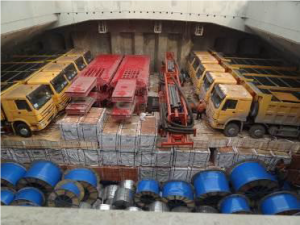
General cargo loaded in a bulk carrier (No CSM)
Recent incidents include:
1.The stowage plan required the ship to load bagged cement onto the tanktop in all holds and then to load general cargo on top of cement in holds. The vehicles were loaded directly on the bagged cement without any dunnage. The usual procedure is for trucks to be loaded into the hold and driven into the final stowage position, which often damages and displaces the cement bags. Lashing points were welded by shipstaff.
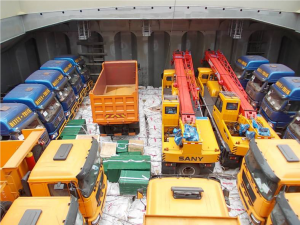
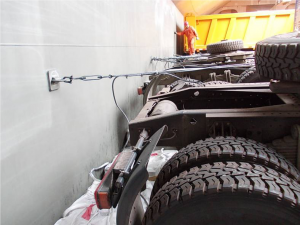
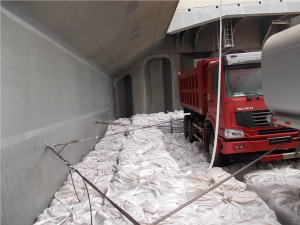
Stowage and lashing of vehicles stowed on top of cement cargo
2.Trucks loaded in China for West African ports, were stowed on the top of bagged cement, with minimal clearance between individual trucks as well as between trucks and hold bulkheads.
Given the lack of adequate support from the cement bags for wheel based cargoes there was a danger of contact damage between the trucks and the bulkheads. Furthermore, potential fire hazards due to fuel in the vehicles’ fuel tanks were not addressed.
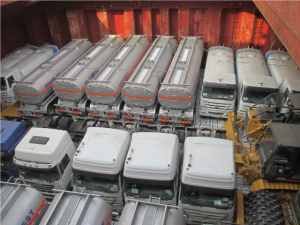
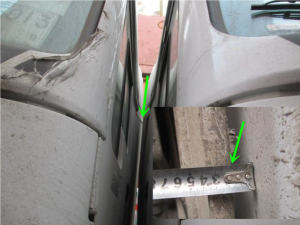
Proximity stowage of vehicles stowed on top of cement cargo
3.General cargo was stowed on top of a bagged cement cargo without any segregation, and also stowed directly against ship’s metallic structures, resulting in bags partly torn in places. The ship did not have a CSM.


Damaged cargo at the discharge port
The International Convention for the Safety of Life at Sea, 1974 (SOLAS) CHAPTER VI, (Carriage of Cargoes Regulation 5 – Stowage and securing) states:
- All cargoes, other than solid and liquid bulk cargoes, cargo units and cargo transport units, shall be loaded, stowed and secured throughout the voyage in accordance with the Cargo Securing Manual approved by the Administration. The Cargo Securing Manual shall be drawn up to a standard at least equivalent to relevant guidelines developed by the Organization.
The International Maritime Organization (IMO), MSC.1/Circ.1353 (Revised Guidelines for the Preparation of the Cargo Securing Manual) provides detailed guidance for preparing a CSM, which is required on all types of ships engaged in the carriage of all cargoes other than solid and liquid bulk cargoes.
Specific areas for attention relevant to this article include the following:
- The CSM must detail all lashing and securing arrangements and devices provided on board the ship including their correct application to and recommended methods for securing of cargo units, containers, vehicles and other cargo which the ship is approved and likely to carry.
- The type and use of lashings must detail all transverse, longitudinal and vertical forces, for a range of applicable metacentric height (GM) values which may arise enroute, particularly during adverse weather and sea conditions. Securing devices must meet acceptable functional and strength criteria applicable to the ship and its cargo.
- Officers and crew, as well as other persons employed for the lashing and securing of cargoes should be instructed on the correct application and recommended use of the cargo securing devices on board the ship.
- The ship specific CSM should also detail the correct application of portable securing devices, taking into account the following:
-
- duration and geographical area of the voyage
- expected sea conditions
- dimensions, design and characteristics of the ship
- expected static and dynamic forces during the voyage
- type, mass and dimensions as well as packaging of cargo units, including vehicles
- recommended stowage and lashing arrangements
Vehicular cargo is often observed to be lashed to non-approved lashing points on bulkheads, and also to each other. Lashings are not checked and tightened regularly, with the failure of any one lashing or lashing point in the chain potentially resulting in vehicles in the stow shifting. Friction between steel cargoes has also been known to result in fires due to frictional heat.
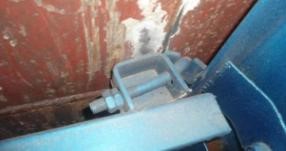
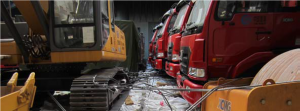
Vehicle and cargo hold damage Inadequate separation, securing and lashings
Loading surveyors are often unsure whether the CSM or ‘loading manual’ prohibits the stowage of vehicles on top of the cement cargo, however it is important to be guided by the basic rules and guidelines for marine cargo stowage and securing.
In general, in accordance with the CSS Code (Annex 4):
Wheel-based cargoes
- Should be secured to the ship by lashings made of material with strength and elongation characteristics at least equivalent to steel chain or wire.
- Where possible, if carried as part cargo should be stowed close to the ship’s side or in stowage positions which are provided with sufficient securing points of sufficient strength, or be block stowed from side to side in the cargo space.
- Where practicable to prevent the shifting, should preferably be stowed in a fore-and-aft direction rather than athwartships. If stowed athwartships, additional securing of sufficient strength may be necessary.
- Brakes should be set and the wheels blocked to prevent shifting
SAFETY
Additional considerations with regard to carriage of vehicles with fuel in their tanks:
- Vehicles are covered by the IMDG Code UN No 3166 which includes special provisions 961 and 962, which allow motor vehicles with fuel in their tanks for their own propulsion to be carried in specially designed ‘Vehicle spaces’. If certain criteria are met regarding fuel tanks being empty, installed batteries being protected from short circuit, they can be accepted as non-dangerous goods otherwise the vehicles are to be declared as Class 9 dangerous goods.
SOLAS regulation II-2/3.49 defines ‘Vehicle Spaces’ as cargo spaces intended for carriage of motor vehicles with fuel in their tanks for their own propulsion.”
(Vehicles or machinery powered by a fuel cell engine shall be consigned under the entries UN 3166 VEHICLE, FUEL CELL, FLAMMABLE GAS POWERED or UN 3166 VEHICLE, FUEL CELL, FLAMMABLE LIQUID POWERED, or UN 3166 ENGINE, FUEL CELL, FLAMMABLE GAS POWERED or UN 3166 ENGINE, FUEL CELL, FLAMMABLE LIQUID POWERED as appropriate. These entries include hybrid electric vehicles powered by both a fuel cell and an internal combustion engine with wet batteries, sodium batteries, lithium metal batteries or lithium ion batteries, transported with the battery(ies) installed ).
- When vehicles or dangerous goods are carried in general cargo holds or on deck, as class 9 UN No 3166 dangerous cargo, the stowage instructions of the IMDG Code shall be followed and stowage shall be in line with the ship’s certificate of fitness to carry dangerous cargo (per SOLAS Reg. II-2/10)
- Additional considerations shall include the fire fighting equipment fitted in and accessible to the cargo holds, particularly when carrying dangerous cargoes
SOLAS Reg. II-2/10
7 Fire-extinguishing arrangements in cargo spaces
7.1 Fixed gas fire-extinguishing systems for general cargo
7.1.3 Except for ro-ro and vehicle spaces, cargo spaces on cargo ships of 2,000 gross tonnage and upwards shall be protected by a fixed carbon dioxide or inert gas fire-extinguishing system complying with the provisions of the Fire Safety Systems Code, or by a fire-extinguishing system which gives equivalent protection.
7.2 Fixed gas fire-extinguishing systems for dangerous goods
A ship engaged in the carriage of dangerous goods in any cargo spaces shall be provided with a fixed carbon dioxide or inert gas fire-extinguishing system complying with the provisions of the Fire Safety Systems Code or with a fire-extinguishing system which, in the opinion of the Administration, gives equivalent protection for the cargoes carried.
Members are reminded of the following considerations when intending to carry break bulk or general cargo in ships, particularly bulk carriers, which are not designed to carry these types of cargo:
Prior to carriage
- A list of the proposed cargo must be obtained from the shipper / charterer, including any stowage or lashing requirements and restrictions (SOLAS, Chapter VI, Regulation 2 and CSS Code sub-chapter 1.9)
- A risk assessment must be undertaken to assess the carriage considerations, cargo care, stowage and lashing requirements and any limitations
- Any ship carrying break-bulk or general cargo is required to carry an approved and up to date CSM, drawn up to a standard at least equivalent to the IMO guidelines, and which is appropriate for all the cargoes to be carried on board that ship. If required, the CSM should be updated to encompass the cargo proposed for carriage
- Responsibilities for stowage and lashing should be clarified and agreed in the charter party in line with the ship’s CSM, and appropriate instructions issued to the master
- If required, a suitable port captain or surveyor should be appointed to assist the master
Pre-loading
- Any additional lashing points in the cargo holds or on deck must be approved by the appropriate flag state administration
- Suitable dunnage and lashing equipment must be provided taking into account the dimensions and stability of the cargo, expected weather conditions enroute and the requirements of the ship specific CSM, the CSS Code and/or SOLAS, as appropriate
During loading
- All loading and lashing must be supervised by ship staff to ensure that the cargo is stowed in compliance with the approved loading and lashing plan
- Appropriate lashings shall be applied to approved lashing points
- Dunnage, chocking and lashing must be checked and verified prior to signing any relevant documentation
En-route
- Regular checks of the cargo and lashing must be undertaken, particularly prior to and after any heavy weather; lashings must be tightened as required
- If any damage is noted, owners/managers, P&I and other relevant parties must be notified promptly
At the discharge port
- The discharge operation should be monitored by ship staff, and any damage noted and signed for
- Pictures and any evidence should be obtained and retained for investigation
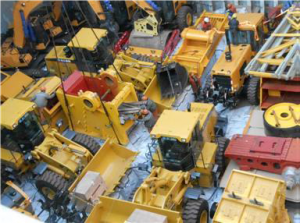
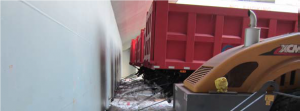
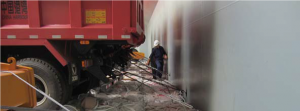
General cargo loaded in a bulk carrier

 English
English